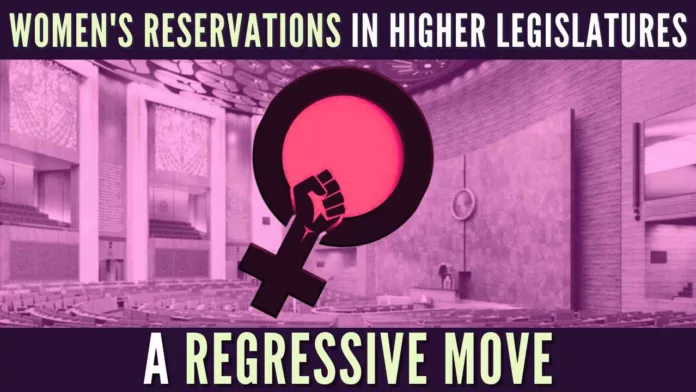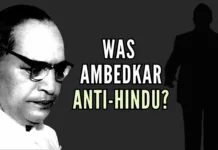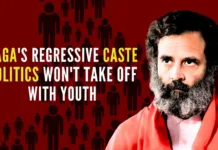
The difference between Sanatana Dharma and Abrahamic religions
Unlike Abrahamic religions, which systemically discriminated against women, as part of their theological doctrine, Sanatana Dharma doesn’t see women as inferior beings. The ruling deities that govern human beings’ lives, especially prosperity, power, and learning are all Goddesses, Mahalakshmi, Shakti, and Saraswathi respectively. In contrast, Abrahamic religions do not have any female deities. There were many Rishikas who contributed to the Vedas in ancient Bharat, many prominent names include Aditi, Apala, Lopamudra, Gargi, Savitri, Maitreyi, Paulomi, and many more. Again, in contrast, there were no major women scholars in Abrahamic religions in the olden days. Women deities, women Rishikas, and scholars in Bharat are not at all surprising, as essentially the nation of Bharat as the name denotes (Bharat – people who are immersed, and glowing in knowledge) was a knowledge society and a knowledge economy, to put it in a modern parlance. Sanatana Dharma, in its theology, doctrines, scriptures, and texts, doesn’t discriminate against women; if anything, women are given huge respect on their own merit, and as mothers. Mother has the primacy of place and is equated with God- Matrudevobhava. In fact, it is considered that men and women are parts of one whole, independent and interdependent, as well as complete each other.
It is also not surprising that possibly the largest number of queens who ruled various kingdoms were in Bharat, compared to any other geography in the world. Therefore it is also not surprising that compared to any other country, a large number of women regularly become MLAs, MPs, ministers, chief ministers, and prime ministers in the Indian subcontinent, including in Muslim countries like Pakistan and Bangladesh, as they once belonged to the ethos of Sanatana Dharma, and hence there is not much resistance in their societies too.
Women Enfranchisement – The women’s suffrage movements in Western `democracies’ versus Bharat
After a relentless women’s suffrage movement that lasted for decades, white western women in some states in the US started getting voting rights in the second decade of the 20th century, that too in phases. It took many more decades for Western women to get full voting rights as it slowly spread to the rest of the US and Europe. It is extremely ironic and also hilarious that Western countries pride themselves as independent democracies. In contrast, India even under a draconian British colonial rule, regularly elected women into provincial and central legislatures, even when a very small percentage of the electorate was eligible to vote; at that corresponding time period, white western women were only beginning to vote. It is evident that in Bharat, the question of whether women should be elected to the provincial assemblies never even arose as the Hindu ethos doesn’t discriminate against women; and India already had a long and great legacy of women queens ruling in many kingdoms.
Dr. Muthulakshmi Reddy, a medical practitioner and a social reformer was nominated to the Madras Legislative Council in the year 1926, much before many western countries gave women enfranchisement in their countries. She also became the Deputy Chairperson of the Legislative Council. Dr. Muthulakshmi’s legendary life is filled with struggles and successes and also demonstrates the natural willingness of society to accept women leaders. Her Brahmin father married her mother who belonged to a devadasi family, and always encouraged her to study and excel; she studied at Madras Medical College, a male college, and became a medical doctor in 1912. As per the standards of those days a century ago, she married late at 28 years of age to Sri Sundar Reddy.
Many women excelled in politics in India since a century or more. Whether as panchayat members, zilla parishad members, city corporators or councilors, MLAs, MPs, ministers, chief ministers, cabinet ministers, or prime ministers, India always had large numbers of illustrious women in public life. The brilliant Nirmala Sitaraman serving as India’s Finance Minister currently, comes to mind immediately among many other prominent women leaders. India again probably is the only nation, where millions of women are enrolled as members in all political parties and are active politically. The majority of women politicians, millions of them are working at the grassroots. It is immensely important to note that for nearly a century, great and not-so-great women leaders, either from entrenched political dynasties, or career politicians or women professionals from other sectors who entered politics, or grassroots women leaders or women who are active in women’s wings of various political parties, lakhs of them made it without any reservations. Except for the women who belong to ruling or once-ruled political dynasties, all other women leaders make it on their own strength and merit, and by the sheer dint of their hard work, in the rough and tumble of Indian politics. Just like men do. People in India are passionate about their politics, and women are no exception.
Many forces in India are actively seeking to divide Indians among caste, religion, ethnicity, state, region, and language lines, and over the decades have succeeded in doing so. In the last few years, it has become increasingly evident as to how fault lines and rifts are being widened, and new strategies and mechanisms are being created to divide Indian society, both from within and without. The increasing attacks on the native Sanatana Dharma by political parties is an alarming pointer.
Cultural Marxism always operates in binaries including in `gender politics’. Gender may be the last barrier, and the Western paradigm of dividing the society among men and women is seeking to be introduced in India too, and the debate is on for a long time. However, the discussants look at Indian society, including on gender issues, through the Western prism, and appropriate Western gender dynamics to an unsuspecting Indian society. It must be recognized that the many aberrations which occurred in India, over the last few centuries of Islamic and colonial rule, which itself is rooted in the Christianity of the Victorian era, resulted in real oppression of women in Indian society. Many aberrations like child marriages, dowry, women’s illiteracy, and many other issues sprang up and persisted in the medieval as well as colonial period. However, as the society is unshackling itself, and is continuously shedding its old colonial mindset, while also making efforts to reconnect to its native roots, we also see that the society is gradually regaining its balance, including on women’s issues.
In this context, is it necessary to bring in legislation for the political empowerment of women? The `Naari Shakti Vandan Adhiniyam 2023’ Act (128th Amendment of the Constitution), passed near-unanimously in the Loksabha on 21st September 2023, aims to create 33% reservation for women in the higher legislatures of the country- parliament and state assemblies, to enhance political participation of women in legislatures and in policy-making. A time frame of 15 years has been provided in the bill. Albeit, it would be implemented a few years later, along with the delimitation process of the parliamentary constituencies. It could be justifiably argued that the 73rd and 74th amendments brought in by the P V Narasimha Rao govt in 1992, which paved the way for 33% of women reservations in Panchayat Raj bodies and in Urban local bodies, has enhanced women’s political participation at the grassroots. However, are women’s reservations required in the higher legislative bodies? Would it not pave the way for more women from political dynasties and families, across all castes, communities, and regions, to be fielded in elections in a big way? Have we not seen how political scions, both men and women, without much merit, have cornered the coveted seats in legislative assemblies and parliament? How does bringing more women from political families on reserved seats become a social reform? Does it not make it more difficult for poor and ordinary but meritorious people to consider politics as a profession?
Progress or regress?
It is an established fact that any temporary measure brought in by legislation, becomes a permanent feature in the country and hence irrevocable in practical terms. We have witnessed how the Modi govt has adroitly managed to abrogate Article 370 pertaining to Jammu & Kashmir in 2019, which apparently was a `temporary and transient’ provision. We also are aware that `caste-based reservations’, initially provided for 10 years, have since been extended decade after decade. The society may reform and change, as Hindu society never remains static, but the political expediencies do not change. Therefore, it would not be a surprise, when `women reservations’ too would be continuously extended every 15 years in the future. When it is proven that the `state’ machinery, doesn’t have the wherewithal to remove `temporary’ measures, where is the necessity to bring in permanent, long-term legislative changes?
It is unanimously agreed that Indian women are making huge strides in all fields of activity, and occupy high positions in all professions. Does an anachronism like reservations fit in with this aspirational nation? Amidst global predictions, that India will surely emerge as an economic power in the next few decades, does the nation need this regressive bill that provides reservations for women in the name of social reform?
Note:
1. Text in Blue points to additional data on the topic.
2. The views expressed here are those of the author and do not necessarily represent or reflect the views of PGurus.
For all the latest updates, download PGurus App.










